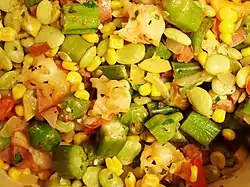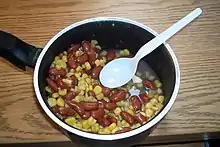 | |
| Alternative names | Sohquttahhash |
|---|---|
| Type | Vegetable dish |
| Course | Main course |
| Place of origin | United States and Canada |
| Region or state | New England |
| Created by | Narragansett |
| Serving temperature | Hot |
| Main ingredients | Sweet corn, lima beans, butter, salt, tomatoes, bell peppers, black pepper |
| Variations | Can also be served with kidney beans |
| ~100 kcal | |
Succotash is a North American vegetable dish consisting primarily of sweet corn with lima beans or other shell beans. The name succotash is derived from the Narragansett word sahquttahhash, which means "broken corn kernels".[1][2] Other ingredients may be added, such as onions, potatoes, turnips, tomatoes, bell peppers, corned beef, salt pork, or okra.[3][4] Combining a grain with a legume provides a dish that is high in all essential amino acids.[5][6]
History
Succotash has a long history. It was an invention of the Indigenous peoples in what is now known as New England. Foreign colonists adapted the dish as a stew in the 17th century. Composed of ingredients unknown in Europe at the time, it gradually became a standard meal in the cuisine of New England[7][8] and is a traditional dish of many Thanksgiving celebrations in the region,[9] as well as in Pennsylvania and other states.
Because of the relatively inexpensive and more readily available ingredients, the dish was popular during the Great Depression in the United States. It was sometimes cooked in a casserole form, often with a light pie crust on top as in a traditional pot pie.
After the abolition of slavery in the United States, freed slaves in the American South returned to Africa and introduced the dish to the region. Today, it is considered one of the national dishes of Equatorial Guinea.
Preparation

Sweet corn (a form of maize), American beans, tomatoes, and peppers (all New World foods) are the usual ingredients.
Catherine Beecher's 19th-century recipe includes beans boiled with corn cobs from which the kernels have been removed. The kernels are added later, after the beans have boiled for several hours. The corn cobs are removed and the finished stew, in proportions of two parts corn to one part beans, is thickened with flour.
Henry Ward Beecher's recipe, published in an 1846 issue of Western Farmer and Gardner, adds salt pork, which he says is "an essential part of the affair."[10]
In some parts of the American South, any mixture of vegetables prepared with lima beans and topped with lard or butter is considered succotash.
In popular culture
- Sylvester the Cat's and Daffy Duck's trademark exclamations are "Thufferin' thuccotash!"
See also
- A Key into the Language of America
- List of legume dishes
- List of maize dishes
- List of regional dishes of the United States
- Umngqusho, a similar dish from Southern Africa
References
- ↑ Trumbull, James Hammond (1903). Natick Dictionary (PDF). Bulletin 25. Washington: Smithsonian Institution, Bureau of American Ethnology. Entry for sohquttahham (page=152).
v.t. he breaks (it) in small pieces, pounds (it) or beats (it) small. The formative tahum according to Howse (Cree Gr. 86), 'implies he beats or batters the object, after the manner of the root.' Inan. pl. sohquttahhamunash, they (grains of corn, Is. 28,28) are broken; otherwise s?hq-, sukq-. Adj. and adv. sohquttahhae, pounded; pl. sohquttahhash, whence the adopted name, succotash. Cf. pohqunnum. [Cree séekwa-tahúm, he beats it into smaller pieces.]
- ↑ Trumbull (1903). Entry for *msickquatash (p. 67; archive p. n194): (Narr.) n.pl. 'boiled corn whole' (i.e. mo-soquttahhash, not broken small or pounded?). See soh-quttahham. When broken, soquttahhash without the prefix. Hence the common name succotash, improperly applied, however, to the unbroken corn.
- ↑ "succotash". The American Heritage Dictionary of the English Language (4 ed.). Houghton Mifflin Company. 2004. Retrieved April 28, 2022.
- ↑ Bowles, Ella Shannon (1947). Secrets of New England Cooking. Barrows.
- ↑ Annigan, Jan. "Nutritional Sources of Essential Amino Acids". Retrieved April 28, 2022.
- ↑ "Essential Amino Acids". hyperphysics.phy-astr.gsu.edu. Retrieved April 28, 2022.
- ↑ (Paywall) "Yes, Succotash Has a Luxurious Side". Retrieved 28 April 2022.
- ↑ "Succotash: Recipe with a History". 28 July 2015. Retrieved 28 April 2022.
- ↑ Morgan, Diane and John Rizzo. The Thanksgiving Table: Recipes and Ideas to Create Your Own Holiday Tradition. Pg. 122.
- ↑ Scharnhorst, Gary. Literary Eats. McFarland. p. 19.
Further reading
- Harper Fussell, Betty (2004). The Story of Corn. UNM Press. pp. 184–185. ISBN 0-8263-3592-6.
External links
 The dictionary definition of succotash at Wiktionary
The dictionary definition of succotash at Wiktionary